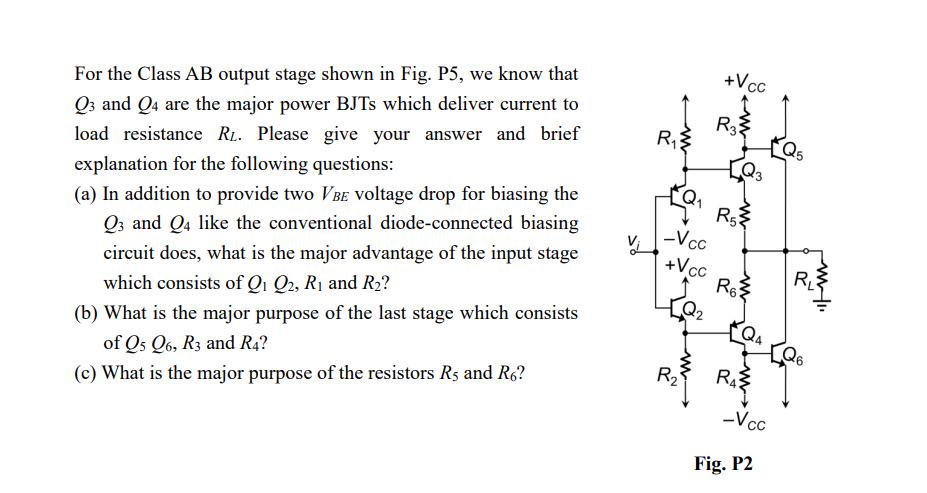Question
For the Class AB output stage shown in Fig. P5, we know that Q3 and Q4 are the major power BJTs which deliver current

For the Class AB output stage shown in Fig. P5, we know that Q3 and Q4 are the major power BJTs which deliver current to load resistance RL. Please give your answer and brief explanation for the following questions: (a) In addition to provide two VBE voltage drop for biasing the Q3 and Q4 like the conventional diode-connected biasing circuit does, what is the major advantage of the input stage which consists of Q1 Q2, R and R? (b) What is the major purpose of the last stage which consists of Q5 Q6, R3 and R4? (c) What is the major purpose of the resistors R5 and R6? Vi R -Vcc +Vcc [Q R +Vcc R R33 R53 R6 R43 -Vcc Fig. P2 R
Step by Step Solution
There are 3 Steps involved in it
Step: 1
a Advantage of the input stage The input stage consisting of Q1 Q2 R and R offers several advantages over a conventional diodeconnected biasing circui...
Get Instant Access to Expert-Tailored Solutions
See step-by-step solutions with expert insights and AI powered tools for academic success
Step: 2

Step: 3

Ace Your Homework with AI
Get the answers you need in no time with our AI-driven, step-by-step assistance
Get StartedRecommended Textbook for
Analysis and Design of Analog Integrated Circuits
Authors: Paul R. Gray, Paul J. Hurst Stephen H. Lewis, Robert G. Meyer
5th edition
1111827052, 1285401107, 9781285401102 , 978-0470245996
Students also viewed these Accounting questions
Question
Answered: 1 week ago
Question
Answered: 1 week ago
Question
Answered: 1 week ago
Question
Answered: 1 week ago
Question
Answered: 1 week ago
Question
Answered: 1 week ago
Question
Answered: 1 week ago
Question
Answered: 1 week ago
Question
Answered: 1 week ago
Question
Answered: 1 week ago
Question
Answered: 1 week ago
Question
Answered: 1 week ago
Question
Answered: 1 week ago
Question
Answered: 1 week ago
Question
Answered: 1 week ago
Question
Answered: 1 week ago
Question
Answered: 1 week ago
Question
Answered: 1 week ago
Question
Answered: 1 week ago
Question
Answered: 1 week ago
Question
Answered: 1 week ago
Question
Answered: 1 week ago
Question
Answered: 1 week ago
View Answer in SolutionInn App



